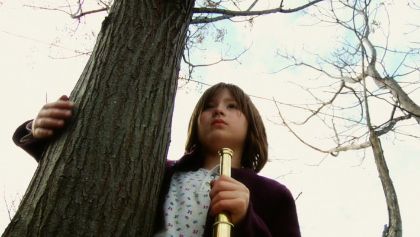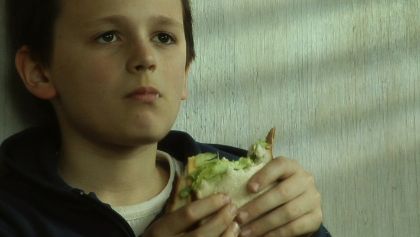« SDFF 2009 - Vincere | Main | SDFF 2009 - Visionaries: Jonas Mekas And The (Mostly) American Avant-Garde Cinema »
November 20, 2009
SDFF 2009 - St. Nick

David Lowery - 2009
Road Dog Productions
Disclosure alert: While I have not personally met David Lowery, his blog, "Drifting" is on my blogroll. We have exchanged a couple of online notes in the past.
Thinking back on St. Nick, I have to reflect on how talented this Texas based filmmaker is based on what could have gone wrong had this film be made by someone of lesser abilities or imagination. Substantially dialogue free, Lowery is able to make his story absorbing from the opening shot. Lowery also understands better than too many contemporary filmmakers, how to compose his shots so that one doesn't get the sense that the camera has been arbitrarily placed. One could say that St. Nick is based on trust, Lowery's faith in his own sense of story telling, and trust that his audience will follow is story based on observing his two children on the run.
We don't know the names of the children, or even if they are running from something or someone, or if they have any destination in mind. The film begins with the boy opening a window into a small frame house that has either been unfinished or abandoned. The boy is resourceful enough to figure out how to get a small wood burning stove working for heat and cooking, and get some very basic plumbing in order. Unlike a Hollywood film, the boy isn't impossibly clever. He and his sister make the house, essentially a wood shell, more livable simply by furnishing it with the abandoned furniture and houseware of others. And unlike a Hollywood film, there is no expository dialogue explaining the children's situation.

Filmed in and around Fort Worth, Lowery pauses from his story to include shots of the bare trees, a spider, and waves of grass. The children find some bones which may been that of a dog. The boy assembles the bones to an approximation of the animal, which the girl "adopts", putting the bones in a cradle. Death, as such, is understood in terms of the mortality of pets.
This sense of nature is extended to a scene where the girl comes across a birthday party in a park. She makes friends with an even younger boy and follows him to the party. The girl encounters some other girls her age who question who she is, and if she attends a certain school. While the girl is able to get some cake, one of the parents questions the girl and asks her to leave the party. St. Nick is about the sense of belonging as determined by both nature and society, as well as one's personal sense of where one should be. This concept of belonging can be found in the ambiguous ending where the girl seems to have a sense of home, while the boy is last seen observing some slow moving freight trains.
Call me on my bias, but I would hope that St. Nick finds life beyond the festival circuit. The virtues of the film recall the best in classic narrative filmmaking. In whatever format St. Nick might be available to you, seek this film out.

Posted by Peter Nellhaus at November 20, 2009 12:24 AM
